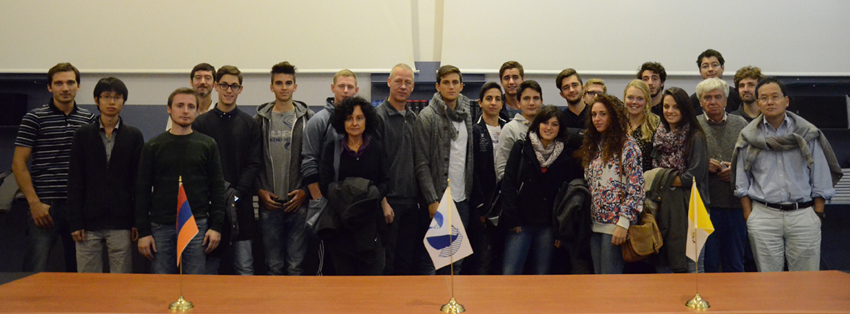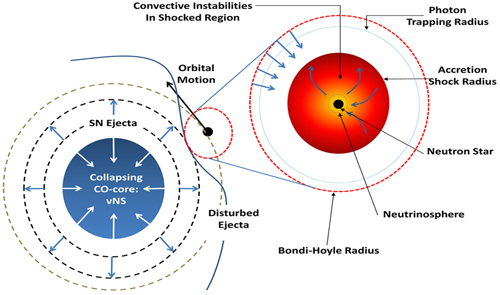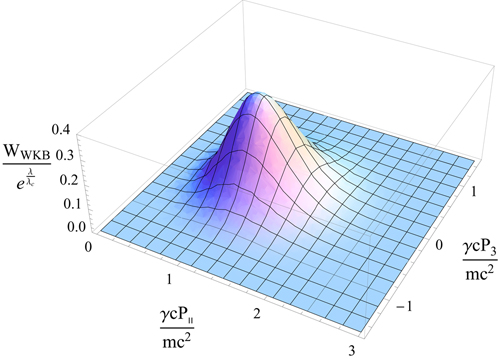

| Newsletter Chinese July/October |

|

|





ICRANet Newsletter
Special Issue
July/October
Yerevan地区ICRANet科学会议(亚美尼亚,2014年6月30日至2014年7月4日):黑洞——宇宙中最大的能源
大会首先由鲁菲尼(Ruffini)教授给了“黑洞、伽玛暴和超新星”的开幕典礼报告,其后的报告涉及物理和相对论天体物理的主要进展方面。这些涵盖了伽玛暴的发现历史和其观测及模型的最新进展,同时也包含了关于理解伽玛暴和超新星联系的最新进展。
在强场分会上,世界级的专家Christoph H. Keitel (德国), Karen Hatsagortsyan (亚美尼亚) 和Antonino Di Piazza (意大利)做了关于利用强激光、激光束聚集的高能光子研究核物理和强电磁场的综述报告。
Razmick Mirzoyan (德国亚美尼亚双国籍) 和Alessandro De Angelis (意大利)给了两个高能伽马射线方面的综述报告。Mirzoyan展示了从MAGIC得到的最新河内及河外源观测结果,含展示了切伦科夫望远镜阵列的现状。De Angelis报告了切伦科夫探测器所研究的相对低能(10GeV附近)的高能伽马射线天体物理。 ICRANet成们员(EMJD学生和ICRANet职员)展示了他们关于伽玛暴和超新星及其和伽玛暴的联系最新研究成果。Jorge Rueda, Riccardo Belvedere和 Kuantay Boshkayev 讨论了中子及最新进展。此外,Eckhard Strobel, 吴远彬和Hendrik Ludwig及其他参会者报告了它们关于强电磁场和讨论了相关物理及天体物理上的应用。, Paolo Giommi和EMJD学生Bruno Sversut报告了一类在TeV能标很有意思的高同步峰值 blazars。他们总结道:它们中的绝大多数都可以在将来被切伦科夫望远镜阵列探测到,而不像偶尔被当前的切伦科夫望远镜看到。来自不莱梅大学的Claus Laemmerzahl教授给了题为“在正则黑洞时空中探测粒子运动”。
泽尔多维奇(Zeldovich)100周年会议记录
所有关于在明斯克举行泽尔多维奇(Zeldovich)100周年会议的贡献论文都汇集到ICRANet。这些包含18篇大会报告和32篇分会报告。这些会议论文将会在2014年底发表在Astronomy Reports增刊(大会报告)和Nonlinear Phenomena in Complex Systems(分会报告)上。这两个期刊均被被Scopus索引,其中Astronomy Reports同时被路透社(Thomson Reuters)索引。增刊编辑是Sergei Kilin (白俄罗斯国家科学院), 雷蒙-鲁菲尼(Remo Ruffini,ICRANet) 和Gregory Vereshchagin (ICRANet)。
十三届意韩相对论天体物理会议(2013年7月15日至19日,梨花女子大学)记录出版
这个会议在每两年在意大利或韩国举行(参见 here ), 除了很多韩国教授、研究者和学生外,超过十个的ICRANe参加者报告了他们的科学学工作。这些会议论文已经发表在“韩国物理学会杂志”上。预 http://link.springer.com/journal/40042/65/6/page/1
ICRANet和爱因斯坦研究所(波茨坦)的合作
在7月份,ICRANet启动了新项目“超对称广义相对论的精确解”,它属于和阿尔伯特-爱因斯坦研究所(德国波茨坦)Hermann Nicolai教授研究组的合作。这个新方向添加到ICRANet的主题研究“爱因斯坦和爱因斯坦-麦克斯韦方程组的精确解”。
更远的目标是构建精确的超对称解。
在巴西、意大利和墨西哥之间签署新的协议
鲁菲尼(Ruffini)教授继续在南美洲进行了显著的外交活动,在七月到八月间和巴西及墨西哥一些主要的大学签署了新的重要协议。
特别的,签署了以下协议:7月1号, Niterói (巴西), 和 UFF - Universidade Federal Fluminense;7月9号在墨西哥城,和 UAM - Universidad Autónoma Metropolitana;8月26号在Florianópolis (巴西) 和UFSC - Universidade Federal de Santa Catarina;8月29号,同样在巴西,和 UFPE - Universidade Federal de Pernambuco。 8月1日在罗马,和Luigi Nicolais教授领导的CNR- National Research Center签署了协议。
ICRANet成功举办了“研究者之夜”
作为连续的第二届,在佩斯卡拉的ICRANet中心参与了国家“2014年研究者之夜”活动。它促进了意大利最大的公共研究活动。9月26日,星期五的早晨,ICRANet的科学家们向150名佩斯卡拉高中最后两年级学生以报告的形式介绍了研究课题。此外,办公楼在晚间开放,并且由向导带领他们参观。这样让他们可以亲眼看到ICRANet的科学家们在加深拓展我们关于星星和统治宇宙规律的认识。
最后,在佩斯卡拉著名的金色大厅,我们中心的一些科学家展示了栩栩如生的会议项目和望远镜观测:鲁菲尼(Ruffini)教授报告了“超新星、伽玛暴和黑洞”;Costantino Sigismondi博士带领大家探讨了“超巨新星和变星”。此外,直到午夜,Luca Izzo和Costantino Sigismondi博士展示了用望远镜观测太阳和星星。
丹麦学生代表团访问佩斯卡拉的ICRANet中心
10月23日,一个来自丹麦Svendborg由六名学生组成的代表团在Mads Fjeldvig Gammeltoft的带领下,作为学生访客的教授Alessandra Palma和在佩斯卡拉Liceo Scientifico "Leonardo da Vinci",访问了我们佩斯卡拉中心。在鲁菲尼(Ruffini)主任问候了他们之后,作为中心成员的Gregory Vereshchagin博士给他们做了题为“光和宇宙探索”的报告。
第十四届Marcel Grossman会议的海报展示(2015年7月12至18日,意大利罗马)
十四届Marcel Grossman会议将会在意大利罗马的罗马大学与2015年7月12日至18日举行。Marcel Grossman会议从1975年开始举办,让大家讨论在引力、广义相对论和相对性场论方面的最新进展。大会强调其数学基础、物理预言和实验检验。这个会议的目的是引出在科学家们对我们理解时空结构和空间及地面为了验证爱因斯坦引力理论的的相关学术交流。历届会议在德里亚斯特(1975年和1979年),上海(1972年),罗马(1985年),Perth(1988年),京都(1991年),斯坦福(1994年),Jerusalem(1997年),罗马(2000年),里约(2003年),柏林(2006年),巴黎(2009年)和斯德哥尔摩(2012年)举行。感兴趣的科学家们应该联系一名会议组委会或会议秘书团的一位成员。
此届的Marcel Grossmann会议因为恰逢爱因斯坦方程的100周年和由UNESO设立的2015世界光年而更为特殊,这个一个相对论天体物理的黄金庆典,所有的一切都会在MG14和其在亚美尼亚、巴西、中国、法国、德国、印度、以色列、韩国、墨西哥和美国的卫星会议上庆祝。 会议海报已经制作完成可以在以下网址下载 http://www.icra.it/mg/mg14/MG14_poster.pdf 科学议程计划还在准别种,正在更新选择的分会和新介绍请参考和联系 网址: http://www.icra.it/MG/mg14/ 电子邮件: mg14@icra.it
ICRANet Faculty and Student’s Scientific Research articles
GRB 130427A and SN 2013cq: A Multi-wavelength Analysis of An Induced Gravitational Collapse Event
R. Ruffini, Y. Wang, M. Kovacevic, C.L. Bianco, M. Enderli, M. Muccino, A.V. Penacchioni, G.B. Pisani, J.A. Rueda
Accepted by ApJ In the particle physics, the interaction between particles generates new particles, named as S-matrix. For instance, a pair of quark and anti-quark produces W/Z boson and Higgs boson, the outcome of electron and positron interaction could be a pair of muon and anti-muon, the duration of such interaction is fleeting, the above two reactions only take 10−26 s and 10−23 s respectively. In the marco-scale astrophysics, some phenomena are apparently similar to the micro-scale particle physics, a famous example is the similarity of electron and blackhole, both can be completely characterized by only mass, electric charge, and angular momentum. Here in our new accepted Astrophysical Journal paper, we introduce a new celestial matrix, C-matrix, an analogue to the S-matrix (Fig.1). C-matrix depicts a binary system composed of one neutron star and one massive star as the initial state, and the products after about 100s interaction are one new neutron star and one black hole. The story of this process can be outlined as: The massive star undergoes a supernova and eject its massive shell, the companion neutron star accretes the ejecta until reaching its critical mass and collapses into a black hole, simultaneously an over critical electrical field is generated around the black hole and electro-positron plasma are produced from it, this plasma flow expands ultra-relativisticly and collides with the inter-stellar medium, which gives origin to the gamma-ray burst (GRB), GRB is considered as an energetic explosion which emits huge abundant photons, mainly the gamma-rays. On April 27, 2013, such aforementioned event occurred and triggered Fermi satellite, later various satellites and telescopes joined the observation. This event was named as GRB 130427A, it is one of the few GRBs which has hundreds of seconds simultaneous data in the optical, X-ray and GeV emission, especially precious is its GeV emission, due to the long duration, high intensity and containing the highest energy photon (95.3 GeV) ever observed in GRBs. We proceeded to make a multi-wavelength analysis. The high energy GeV emission appears to be detectable at the end of the prompt radiation phase(∼ 20s), when the fluence of X-ray and γ-ray of the prompt exponentially decrease and becomes transparent for GeV photons. After 200s, the Lorentz factors of X-ray and GeV are very different, and their physical origin are necessarily different. The high energy can originate from the interaction of some of the physical components (e.g., neutron star and black hole) newly created in the C-matrix. ![fig1 [fig1]](newsletters/luglio2014/fig1_small.jpg)
Figure 1: Three different matrices in fundamental physics. The first is the quark matrix leading to a Higgs boson. In the middle is the classical electron-positron pair matrix, generating an muon and anti-muon pair. The third matrix is the celestial one, which is considered in the present work. ∆t is the duration of intermediate state. The interaction of the GRBs with the SN ejecta may well generate the X-ray emission and the associated thermal component. By analyzing the X-ray data from 195s to 461s, a crucial evidence was found, that adding a blackbody component could efficiently improve the fitting (Fig. 3), the obtained blackbody temperature is in the range of 0.3 KeV to 0.5 KeV, the radiation radius is deduced from about 7 × 1012 cm to 2.8 × 1013 cm, with the expansion speed at 0.8c, c is the speed of light. These above value is typical for the supernova ejecta accelerated by the collision with GRB outflow. GCN 14526: The late X-ray observations of GRB 130427A by Swift-XRT clearly evidence a pattern typical of a family of GRBs associated to supernova (SN) following the Induce Gravitational Collapse (IGC) paradigm (Rueda & Ruffini 2012; Pisani et al. 2013). We assume that the luminosity of the possible SN associated to GRB 130427A would be the one of 1998bw, as found in the IGC sample described in Pisani et al. 2013. Assuming the intergalactic absorption in the I-band (which corresponds to the R-band rest-frame) and the intrinsic one, assuming a Milky Way type for the host galaxy, we obtain a magnitude expected for the peak of the SN of I = 22 - 23 occurring 13-15 days after the GRB trigger, namely between the 10th and the 12th of May 2013. Further optical and radio observations are encouraged. After the first days observation, we found that the X-ray afterglow of GRB 130427A overlaps other GRBs induced by C-matrix (Fig.4), we concluded that this new GRB shared the same mechanism, which means a supernova is inevitable in the system though the optical signal is too weak too be observed, immediately we sent a letter to GCN on May 2, 2013, predicting that the optical R-band of a SN will reach its peak magnitude in about 10 days in the cosmological rest-frame on the basis of the IGC paradigm, and we encouraged observations. ![fig2 [fig2]](newsletters/luglio2014/fig2_small.jpg)
Figure 2: Flux of first 700 s. Blue points are the Fermi-LAT high energy emission from 100 MeV till 100 GeV, grey dotted line represents the Fermi-GBM, from 10 keV to 900 keV, green dashed line represents the photons detected by Swift BAT from 10 keV to 50 keV, and red solid line is the soft X-ray Swift-XRT detection, in the range of 0.3 KeV to 10 KeV. From this figure, clearly the Fermi-LAT emission reaches highest fluence at about 20 s while the gamma-ray detected by Fermi-GBM releases most of the energy within the first 10 s. ![fig3 [fig3]](newsletters/luglio2014/fig3_small.jpg)
Figure 3: Spectral fitting of three time intervals (196s - 246s, 246s - 326s, 326s - 461s) in Episode 3, data come from Swift-XRT (0.3 KeV - 10 KeV, without pile-up area). Black points are the deduced data, green dashed line presents the thermal component, blue long-dashed line is the power law component, and red line shows the combination of these two components. Clearly the flux of thermal component drops and the temperature decreases along the time. ![fig4 [fig4]](newsletters/luglio2014/fig4_small.jpg)
Figure 4: Overlapping of GRB 130427A and GRB 060729. Green cross is the light curve of GRB 060729. Red triangle and orange dots represent the light curve of GRB 130427A respectively before and after May 2, 2013. The vertical line marks the time of 2 × 104 s which is the lower limit for the domain of validity of the Pisani relation prior to GRB 130427A.
Letter in collaboration with Pror. Fryer, Los Alamos:
Hypercritical Accretion, Induced Gravitational Collapse, And Binary-Driven Hypernovae
Chris L. Fryer, Jorge A. Rueda, Remo Ruffini
ApJ Letters 793, 36 (2014) The induced gravitational collapse (IGC) paradigm has been successfully applied to the explanation of the concomitance of gamma-ray bursts (GRBs) with supernovae (SNe) Ic. The progenitor is a tight binary system composed by a carbon-oxygen (CO) core and a neutron star (NS) companion. The explosion of the SN leads to hypercritical accretion onto the NS companion which reaches the critical mass, hence inducing its gravitational collapse to a black hole (BH) with consequent emission of the GRB. The first estimates of this process were based on a simplified model of the binary parameters and the Bondi-Hoyle-Lyttleton accretion rate. We present here the first full numerical simulations of the IGC phenomenon. We simulate the core-collapse and SN explosion of CO stars to obtain the density and ejection velocity of the SN ejecta. We follow the hydrodynamic evolution of the accreting material falling into the Bondi-Hoyle surface of the NS all the way up to its incorporation to the NS surface. The simulations go up to BH formation when the NS reaches the critical mass. For appropriate binary parameters the IGC occurs in short timescales (100-1000s) owing to the combined effective action of the photon trapping and the neutrino cooling near the NS surface. We also show that the IGC scenario leads to a natural explanation for why GRBs are associated only to SN Ic with totally absent or very little helium.
Semiclassical pair production rate for time-dependent electrical fields with more than one component: WKB-approach and world-line instantons
Strobel, Eckhard; Xue, She-Sheng
Nuclear Physics B 886, 1153 (2014) Description: The Schwinger-effect describes how pairs of electrons and positrons can be produced from the vacuum with the help of a very strong electric field. While this effect is believed to play a important rule in astrophysics, especially for gamma ray burst, it has never been observed directly in a laboratory. The reason for this is that currently one can not produces the field strengths which are necessary to produce a measurable number of pairs. This might change with the construction of new high energy laser systems, like the Extreme Light Infrastructure (ELI). It has recently been shown that pair creation rate changes over several orders of magnitude depending on the form of the laser pulse. To design an experiment in which Schwinger pair creation can be measured directly it is substantial to understand this dependence. While a lot of computations can be performed numerical it is worthwhile to continue to study approximate analytical methods to strengthen this understanding. In the paper we generalize two well-known analytical methods, namely the WKB and the world line instant on method, to fields which have more than one time-dependent component. The comparison of the two methods shows when to best use which of the methods. The generalizations enables us to find a analytic solution for the momentum spectrum of the produced pairs in a rotating electric field. As displayed in Figure no pairs are produced which have zero momentum. This is a big difference to the known cases of one-component fields, where most pairs are produced with zero momentum. Since the rotating electric field is a approximation for the field in the anti-node of a circularly polarized standing wave, which can be produced in laser experiments, the characteristic shape of this momentum spectrum might help to distinguish the pairs produced by the Schwinger process from those produced due to other strong field effects.
Submitted Articles:
Induced Gravitational Collapse At Extreme Cosmological Distances: The Case Of Grb 090423
R. Ruffini, L. Izzo, M. Muccino, G.B. Pisani, J.A. Rueda, Y. Wang, C. Barbarino, C.L. Bianco, M. Enderli, M. Kovacevic A&A 569, A39 (2014)
The Genuine Short Grb 090227b And The Disguised By Excess Grb 090510
M. Muccino, C.L. Bianco, L. Izzo, Y. Wang, M. Enderli, M. Kovacevic, G.B. Pisani, A.V. Penacchioni, R. Ruffini Gravitation and Cosmology, 20, 197 (2014)
On The Core-Halo Distribution Of Dark Matter In Galaxies
Remo Ruffini, Carlos Argüelles, Jorge A. Rueda Submitted to Phys. Rev. Lett.
Just Published Articles:
Semiclassical Pair Production Rate For Time-Dependent Electrical Fields With More Than One Component: Wkb-Approach And World-Line Instantons
Strobel, Eckhard; Xue, She-Sheng Nuclear Physics B 886, 1153 (2014)
Transparency Parameters From Relativistically Expanding Outflows
Bégué, D.; Iyyani, S. ApJ 792, 42 (2014)
Dynamical Instability Of White Dwarfs And Breaking Of Spherical Symmetry Under The Presence Of Extreme Magnetic Fields
J. G. Coelho, R. M. Marinho, M. Malheiro, R. Negreiros, D. L. Cáceres, J. A. Rueda, R. Ruffini ApJ 794, 86 (2014)
Are The Most Super-Massive Dark Compact Objects Harbored At The Center Of Dark Matter Halos?
Carlos R. Argüelles, Remo Ruffini Essay selected for Honorable mention 2014 by the Gravity Research Foundation
Strangeness Content Of Neutron Stars With Strong Sigma-Hyperon Repulsion
M. Razeira, A. Mesquita, C. A. Z. Vasconcellos, R. Ruffini, J. A. Rueda, R. O. Gomes Astronomische Nachrichten 335, 739 (2014)
Effective Field Theory For Neutron Stars With Strong Sigma--Hyperon Repulsion
M. Razeira, A. Mesquita, C. A. Z. Vasconcellos, R. Ruffini, J. A. Rueda, R. O. Gomes Astronomische Nachrichten 335, 733 (2014)
A search for Fermi bursts associated with supernovae and their frequency of occurrence
Kovacevic, M.; Izzo, L.; Wang, Y.; Muccino, M.; Della Valle, M.; Amati, L.; Barbarino, C.; Enderli, M.; Pisani, G. B.; Li, L. Astronomy & Astrophysics, Volume 569, id.A108, 6 pp. (A&A Homepage) |
|||||||
|
||











